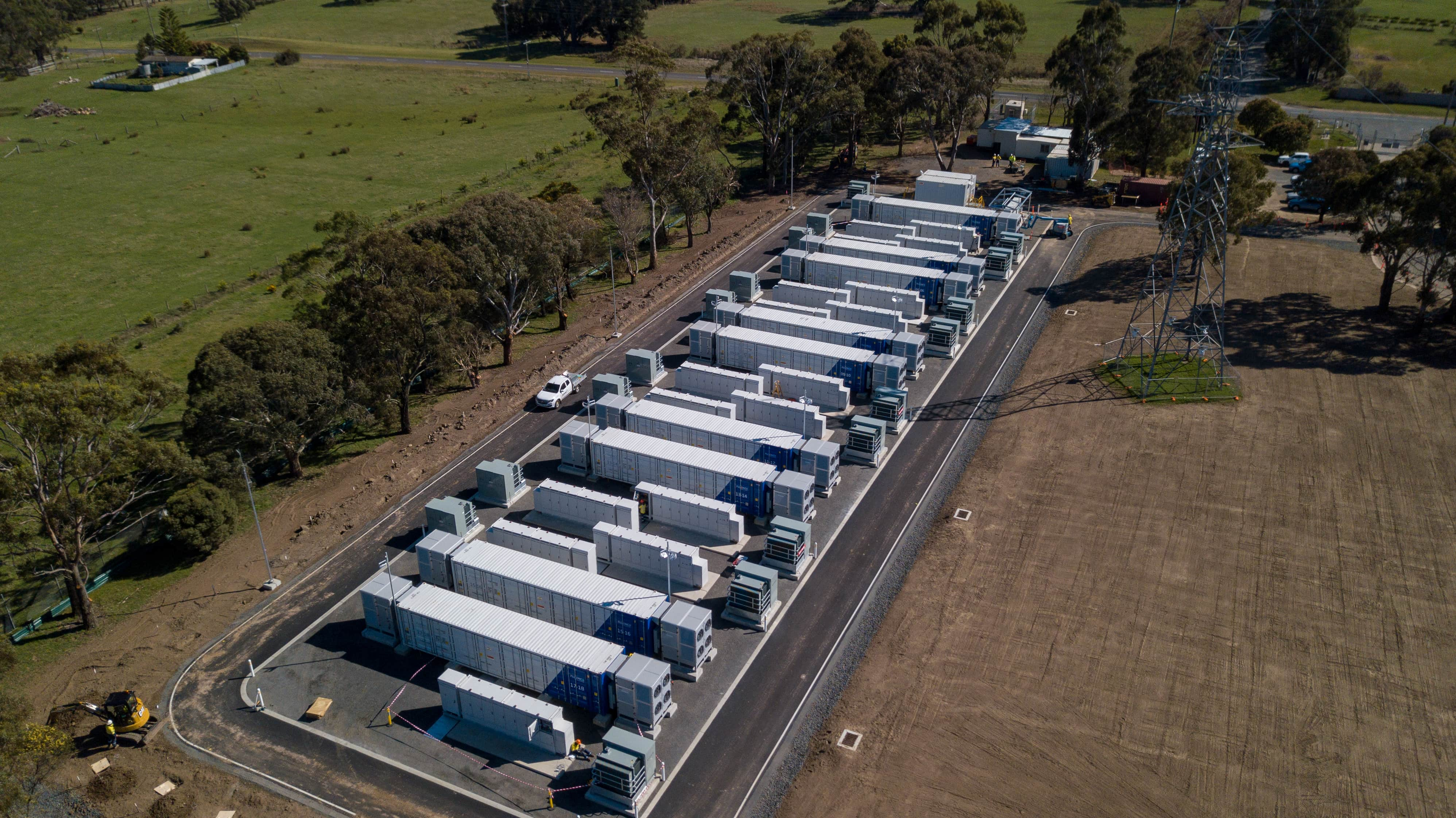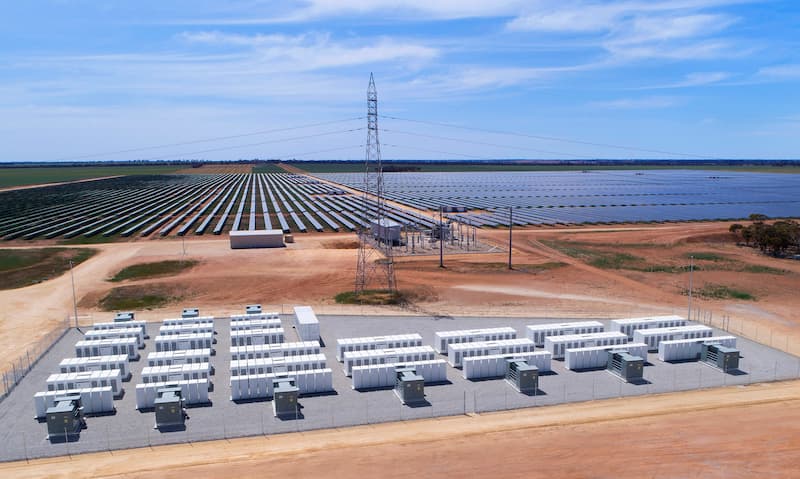On this page:
Storage is a vital part of our electricity grid. In the future, much of our energy will be generated closer to where it is used and the way we use it will be more efficient.
Our modern energy system will be backed by household, neighbourhood and large-scale batteries and new long-duration storage.
That’s why we have legislated nation-leading storage targets of at least 2.6 gigawatts (GW) by 2030 and 6.3 GW by 2035.
Backing up renewable generation
By 2035, at least 6.3 GW of new short and long-duration storage will be in place, supported by targeted gas-fired power generation to ensure electricity supply in periods of peak demand and when there is low or no wind and solar generation.
Around 7.6 GW of additional rooftop solar and 4.3 GW of distributed storage will be installed, including behind-the-meter batteries, demand-side participation and smaller front-of-meter assets such as neighbourhood batteries.
Read more in Cheaper, Cleaner, Renewable: Our Plan for Victoria’s electricity future.
Types of batteries
Big batteries
Victoria has 12 commissioned large-scale storage systems and 3 in commissioning – with a total output capacity of 1028 MW and storage capacity of more than 1.7 GWh.
Storage capacity = how much total energy is stored in each battery.
Output capacity = how much energy a battery can provide at a given time.
A further 13 batteries are under construction and 46 batteries have been granted development approval.
Big batteries are being delivered through the SEC, Victorian Renewable Energy Target (VRET) program, Structured Transition Agreements, the Renewable Energy Zone (REZ) Stage 1 program, Energy Innovation Fund and more.
Neighbourhood batteries
Smaller than a big (or utility-scale) battery, but larger than a household battery, neighbourhood batteries can soak up cheap, renewable energy from rooftop solar during the day and feed it back into the community or the organisations they are connected to, when power usage is high.
The Victorian Government has supported neighbourhood batteries through the 100 Neighbourhood Batteries program and Neighbourhood Battery Initiative.
The Victorian Government has funded 90 neighbourhood battery projects across metropolitan and regional Victoria to date. For a full list of locations and more information, visit Neighbourhood batteries.
Household batteries
Household batteries are about 10 KW and are designed to help you store your own rooftop solar power at home, to avoid paying retail costs in the peak periods or overnight.
Victorian Government support for energy storage
Victorian Big Battery
Opened in 2021, the 300 MW/450 MWh Victorian Big Battery is one of the largest batteries in Australia.
Through Victorian Government support, the battery provides a System Integrity Protection Scheme (SIPS) service to the State, allowing for an increased import limit on the Victoria – New South Wales Interconnector.
This secures an additional 250 MW of electricity supply to Victoria during the hot summer months, reducing the likelihood of blackouts.
Terang Battery Energy Storage System
As a part of the Victorian Government’s Energy Innovation Fund, a 100 MW/200 MWh battery with grid forming inverters is being constructed at Terang.
The system will provide voltage and frequency control technology to manage the supply and demand of electricity flowing through the network and keep the network performing reliably. This technology is critical as more renewable energy is connected to the grid.
Wooreen Battery
Through the Victorian Government’s agreement to support EnergyAustralia in the transition of the Yallourn Power Station, EnergyAustralia is constructing the 350 MW, four-hour Wooreen Battery, to be delivered in 2027 ahead of the closure of Yallourn.
Bulgana Green Power Hub
In December 2017, the Victorian Government signed a 15-year support agreement with Neoen Australia to deliver the Bulgana Green Power Hub - a 20 MW battery paired with a 200 MW wind farm.
Energy Storage Initiative
In 2017, the Victorian Government announced a $25 million Energy Storage Initiative.
The Energy Storage Initiative supported energy storage technologies and projects to:
- improve the reliability of Victoria’s electricity system
- drive the development of clean technologies
- boost the local economy
- enhance system security, resilience and reliability.
In March 2018, 2 projects in Western Victoria were chosen to be part of The Energy Storage Initiative – one in Ballarat and one in Gannawarra.
Construction for the Ballarat and Gannawarra Energy Storage Systems was completed in late 2018. Both batteries began operating over the summer of 2018 and 2019.
Ballarat Energy Storage System
The Ballarat Energy Storage System is located at the Ballarat Terminal Station in Warrenheip, Victoria. Spotless Sustainability Services lead the construction of the 30 MW/30 MWh battery.
The Ballarat Energy Storage System provides back-up power and grid stabilisation, vital to maintaining a reliable and affordable energy supply in Western Victoria.

Gannawarra Energy Storage System
The Gannawarra Energy Storage System is located at the Gannawarra Solar Farm in Wandella, Victoria.
The 25 MW/50 MWh battery is a Tesla Powerpack system. It’s jointly owned by Edify Energy and Wirsol Energy and operated by Energy Australia.
This battery is used to smooth the output of the Gannawarra solar farm, allowing the combined solar and battery system to provide power when there is no sun.
The Gannawarra project is the largest integrated solar farm and battery project in Australia and among the largest in the world.

SEC
The Victorian Government has brought back the SEC to co-invest with the private sector and speed up the transition to renewables.
The SEC will put power back in Victorians’ hands, including by investing an initial $1 billion towards building 4.5 GW of new renewable energy generation and storage projects by 2035.
This includes the 600 MW/1.6 GwH Melbourne Renewable Energy Hub, and the SEC Renewable Energy Park – Horsham, a 100 MW battery and 119 MW co-located solar farm, which is one of Australia’s first 100% publicly owned utility-scale energy projects.
Partnership on the Capacity Investment Scheme
The Victorian Government has a bilateral Renewable Energy Transformation Agreement (RETA) that sets out allocations under the Commonwealth Capacity Investment Scheme (CIS) for Victorian renewable energy and storage projects.
Through the RETA, Victoria has secured support for a minimum 1.7 GW of 4-hour equivalent storage capacity to be awarded via national CIS tenders between 2024 and 2026.
Structured Transition Agreements
Victoria has Structured Transition Agreements (STAs) in place with the owners of Victoria’s largest the coal-fired power stations, Yallourn and Loy Yang A, that will see these assets close in 2028 and 2035, respectively.
As part of the Yallourn STA, EnergyAustralia is constructing the 350 MW, four-hour Woorreen Battery to be delivered in 2027, ahead of the closure of the power station.
100 Neighbourhood Batteries program
The Victorian Government has supported neighbourhood batteries through the 100 Neighbourhood Batteries program and Neighbourhood Battery Initiative.
VRET program
The VRET program will deliver a further 365 MW of new energy storage.
REZ Stage 1 program
The REZ Stage 1 program supported the 125 MW Koorangie Battery Energy Storage System (BESS) with grid forming inverter technology near Kerang to provide system strength services.
Energy Innovation Fund
Supported installation of a 100 MW/2-hour lithium-ion battery energy storage system using new grid forming inverters near Terang.
Solar Homes Program
Battery rebates and interest-free loans delivered through Solar Victoria from 2019 to mid-2025 supported the installation of more than 20,000 solar batteries in homes across Victoria.
This far exceeded the initial program commitment of 10,000 installations and equates to 243.8 MWh of battery capacity installed.
Page last updated: 02/09/25
